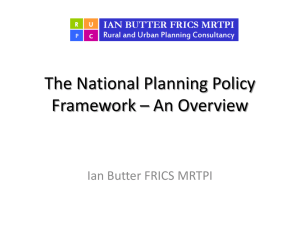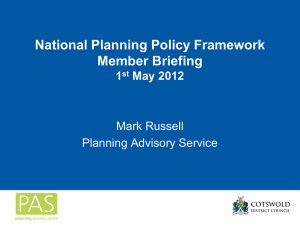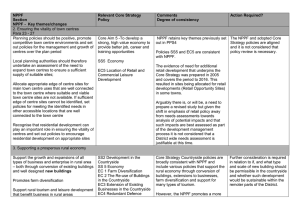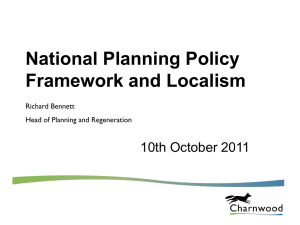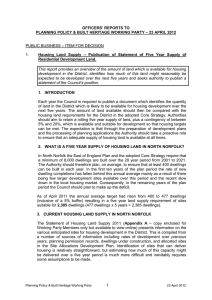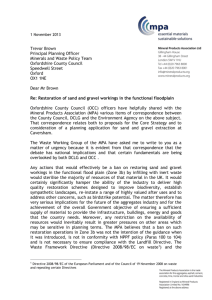National Planning Policy Framework (NPPF)
advertisement
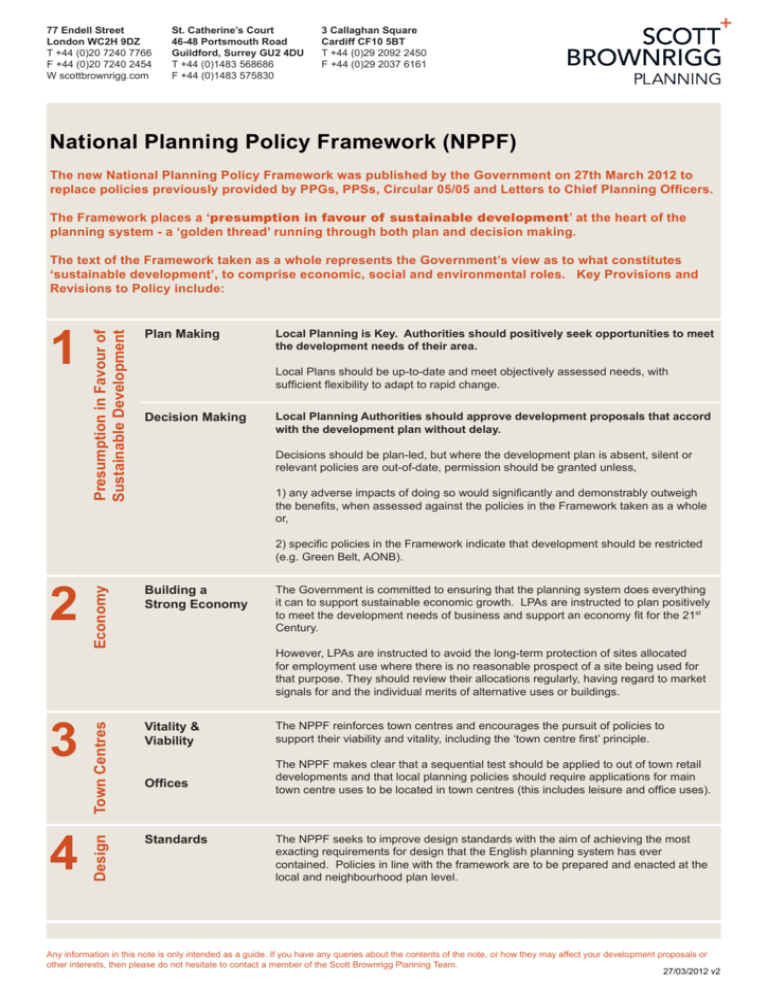
77 Endell Street London WC2H 9DZ T +44 (0)20 7240 7766 F +44 (0)20 7240 2454 W scottbrownrigg.com St. Catherine’s Court 46-48 Portsmouth Road Guildford, Surrey GU2 4DU T +44 (0)1483 568686 F +44 (0)1483 575830 3 Callaghan Square Cardiff CF10 5BT T +44 (0)29 2092 2450 F +44 (0)29 2037 6161 National Planning Policy Framework (NPPF) The new National Planning Policy Framework was published by the Government on 27th March 2012 to replace policies previously provided by PPGs, PPSs, Circular 05/05 and Letters to Chief Planning Officers. The Framework places a ‘presumption in favour of sustainable development’ at the heart of the planning system - a ‘golden thread’ running through both plan and decision making. 1 Presumption in Favour of Sustainable Development The text of the Framework taken as a whole represents the Government’s view as to what constitutes ‘sustainable development’, to comprise economic, social and environmental roles. Key Provisions and Revisions to Policy include: Plan Making Local Planning is Key. Authorities should positively seek opportunities to meet the development needs of their area. Local Plans should be up-to-date and meet objectively assessed needs, with sufficient flexibility to adapt to rapid change. Decision Making Local Planning Authorities should approve development proposals that accord with the development plan without delay. Decisions should be plan-led, but where the development plan is absent, silent or relevant policies are out-of-date, permission should be granted unless, 1) any adverse impacts of doing so would significantly and demonstrably outweigh the benefits, when assessed against the policies in the Framework taken as a whole or, 4 Economy 3 Town Centres 2 Building a Strong Economy Vitality & Viability The NPPF reinforces town centres and encourages the pursuit of policies to support their viability and vitality, including the ‘town centre first’ principle. Offices The NPPF makes clear that a sequential test should be applied to out of town retail developments and that local planning policies should require applications for main town centre uses to be located in town centres (this includes leisure and office uses). Design 2) specific policies in the Framework indicate that development should be restricted (e.g. Green Belt, AONB). Standards The Government is committed to ensuring that the planning system does everything it can to support sustainable economic growth. LPAs are instructed to plan positively to meet the development needs of business and support an economy fit for the 21st Century. However, LPAs are instructed to avoid the long-term protection of sites allocated for employment use where there is no reasonable prospect of a site being used for that purpose. They should review their allocations regularly, having regard to market signals for and the individual merits of alternative uses or buildings. The NPPF seeks to improve design standards with the aim of achieving the most exacting requirements for design that the English planning system has ever contained. Policies in line with the framework are to be prepared and enacted at the local and neighbourhood plan level. Any information in this note is only intended as a guide. If you have any queries about the contents of the note, or how they may affect your development proposals or other interests, then please do not hesitate to contact a member of the Scott Brownrigg Planning Team. 27/03/2012 v2 9 Brownfield First Principle 8 Following objection from a number of groups, the NPPF encourages the effective use of land by re-using land that has been previously developed (Brownfield), provided that it is not of high environmental value. Mixed-Uses The Framework promotes mixed use developments, encouraging multiple benefits from the use of land in urban and rural areas, recognising that some open land can perform many functions (e.g. wildlife, recreation, flood risk, carbon storage etc) Housing Policy 7 Brownfield Land Housing Land Supply Councils will be required to maintain a five year housing land supply with an additional buffer of 5% to ensure choice and competition in the market for land. The buffer may rise to 20% in areas where ‘there has been a record of persistent under delivery of housing’. Change from commercial to residential should normally be approved where there is identified need unless there are strong economic reasons why it would be inappropriate. Density Local authorities to set their own approach to housing density to reflect local circumstances. Windfalls Local authorities may now make an allowance for windfall sites in their five-year supply if they have compelling evidence that such sites have consistently become available in the local area and will continue to provide a reliable source of supply. But the allowance should not include residential gardens. Larger Scale 6 3 Callaghan Square Cardiff CF10 5BT T +44 (0)29 2092 2450 F +44 (0)29 2037 6161 Garden City Principles The NPPF outlines that the supply of new homes can sometimes be best achieved through planning for larger scale development, such as new settlements or extensions to existing villages or towns that follow the principles of Garden Cities. Countryside 5 St. Catherine’s Court 46-48 Portsmouth Road Guildford, Surrey GU2 4DU T +44 (0)1483 568686 F +44 (0)1483 575830 Green Belt The Framework reinforces the importance placed upon the protection of the Green Belt - once established, Green Belt boundaries should only be altered in exceptional circumstances, through the preparation or review of the Local Plan. Local Plans 77 Endell Street London WC2H 9DZ T +44 (0)20 7240 7766 F +44 (0)20 7240 2454 W scottbrownrigg.com Transitional Arrangements More generally, the intrinsic character and beauty of the countryside should be recognised as a core planning principle There will be a 12 month transitional period for planning authorities to amend their local plans so that they conform more closely with the NPPF. This is likely to be highly contentious, particularly in areas where existing local plans pre-date 2004 and there is no prospect of a Local Plan coming forward within a 12-month timescale. In such circumstances and where performance in the delivery of housing or other development in an area is poor, the NPPF is live and a material consideration of significant weight. Authorities in such areas will need to bring their plans forward as quickly as possible. The NPPF forms part of the Government’s ongoing reform of the Planning system. Other key reforms to be aware of include (but are not limited to) neighbourhood planning and other changes brought about by the Localism Act 2011; and the Community Infrastructure Levy and adoption of Local Authority Charging Schedules. If you would like further information on these changes, please contact a member of the Planning Team London: Guildford: c.tennant@scottbrownrigg.comj.bray@scottbrownrigg.com Any information in this note is only intended as a guide. If you have any queries about the contents of the note, or how they may affect your development proposals or other interests, then please do not hesitate to contact a member of the Scott Brownrigg Planning Team. 27/03/2012 v2
